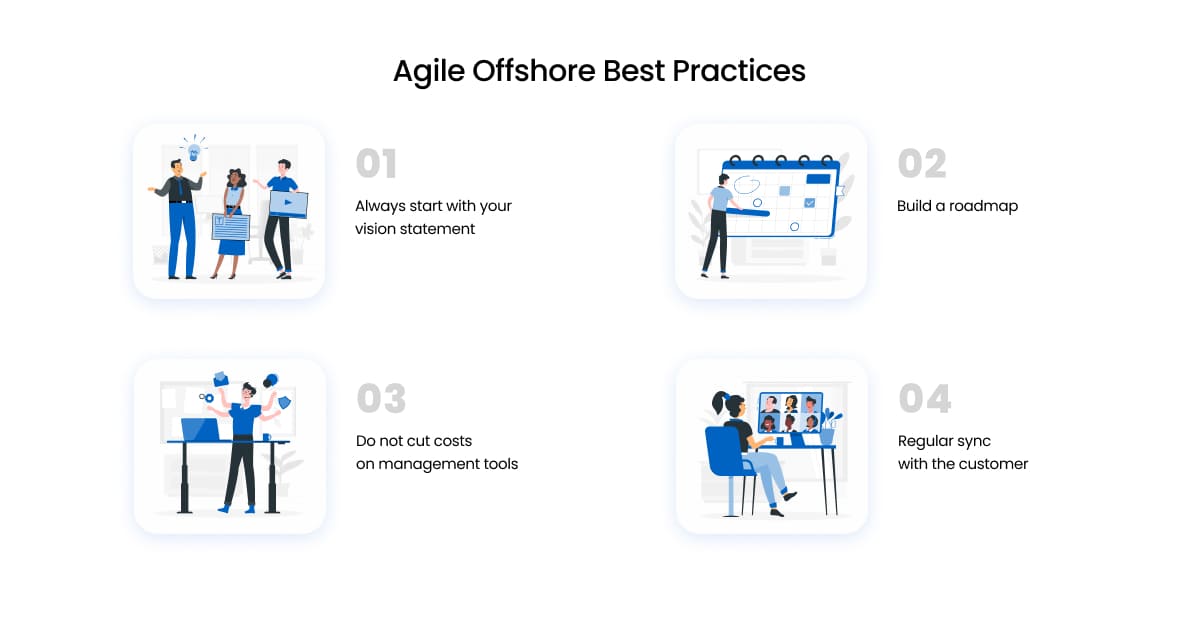
In the race to keep up with the fast-paced and competitive business world, companies are looking for efficient and budget-friendly ways to create top-notch software solutions. Agile offshore development, a rising star in this scenario, seamlessly blends the flexible principles of agile methodologies with the perks of offshore outsourcing. Let’s delve into agile offshore development, exploring its advantages, navigating challenges, and uncovering best practices.
Understanding Agile Methodologies
Agile methodologies, like Scrum and Kanban, dance to the tune of iterative and incremental development, constant customer feedback, and team collaboration. They’re like the maestros orchestrating shorter development cycles, allowing businesses to adapt swiftly to changing requirements and market conditions. The magic lies in their promotion of transparency, flexibility, and continuous improvement, making them perfect for the intricate dance of complex and dynamic projects.
The Offshore Advantage
Offshore outsourcing is the rockstar of the cost-saving world, offering a golden ticket to a diverse talent pool. By joining forces with offshore development teams, businesses can tap into a global network of skilled professionals offering competitive rates and specialized expertise. Picture this as a 24/7 development jam session, where different teams work harmoniously across time zones, ensuring continuous progress and a faster route to market.
Benefits of Agile Offshore Development
Accelerated Time-to-Market: Agile offshore development puts the pedal to the metal, allowing companies to showcase their products or services faster. By breaking down projects into bite-sized sprints and involving offshore teams from the get-go, development becomes a speedway where features seamlessly integrate.
Cost Savings
In the world of agile offshore development, cost reduction takes center stage. With their competitive rates, offshore teams become the key players, allowing businesses to dance to the rhythm of budget optimization without compromising quality.
Access to a Global Talent Pool
Offshore development is like having a backstage pass to a talent concert. Companies get to mingle with skilled professionals from various corners of the world, each bringing their unique flair to the innovation table, fostering the creation of high-quality software solutions.
24/7 Development Cycle
Imagine a non-stop party where the music never fades. Offshore teams operating in different time zones ensure round-the-clock development cycles. It’s a symphony of progress that keeps the project on a constant crescendo, responding swiftly to market demands.
Overcoming Challenges in Agile Offshore Development
While this development dance has its perks, it’s not without its tricky steps.
Communication and Collaboration: Clear and frequent communication is key to overcoming geographical and cultural barriers. Video conferencing, instant messaging, and project management tools form the dance floor where alignment and transparency take center stage.
Time Zone Differences
Coordinating across time zones might seem like a dance of its own. Establishing overlapping working hours and employing asynchronous communication methods keep the rhythm flowing, preventing stumbling blocks.
Cultural and Language Barriers
Cultural and language differences can disrupt the dance of collaboration. A dash of cultural sensitivity, language training, and team-building activities create a harmonious atmosphere where understanding prevails.
Managing Distributed Teams
Managing a team scattered across the globe requires a special choreography. Clear roles, well-defined objectives, and robust project management practices are the moves that ensure the dance stays graceful. Regular check-ins and team-building initiatives keep everyone in sync.
Best Practices for Successful Agile Offshore Development
Establish Clear Communication Channels
The melody of success starts with open and transparent communication channels. Regular synchronous and asynchronous meetings keep the dialogue alive, ensuring everyone dances to the same beat.
Foster a Collaborative Environment
Encouraging a collaborative work environment is the secret ingredient for a successful dance. Teamwork, interaction opportunities, and the exchange of ideas between onshore and offshore teams create a dance floor where innovation takes center stage.
Embrace Agile Principles and Practices
The choreography of success includes adopting agile principles and practices. Daily stand-ups, sprint planning, and continuous integration become the well-rehearsed routines that ensure agility in offshore projects, delivering a performance that wows the audience.
Choose the Right Offshore Partner
Selecting the perfect dance partner is crucial. Consider expertise, experience, cultural compatibility, communication skills, and a proven track record. A strong partnership and mutual trust set the stage for a performance that steals the show.
Conclusion
Agile offshore development offers a rhythm that resonates with businesses seeking efficient and cost-effective software solutions. By blending the flexibility of agile methodologies with the global reach of offshore outsourcing, companies can create a symphony of success. Yet, effective communication, collaboration, and management are the choreographed steps that ensure this dance dazzles. By following best practices and choosing the right partner, organizations can dance their way to the full potential of agile offshore development.
FAQs
Q1. Is agile offshore development suitable for all types of software projects?
A1. Agile offshore development is like a versatile dance partner, fitting well with various software projects, including complex and dynamic ones. Its flexibility and adaptability make it an excellent choice for projects that crave iterative and collaborative moves.
Q2. How can communication challenges in agile offshore development be mitigated?
A2. Overcoming communication hurdles is like refining dance steps. Well-defined communication channels, project management tools, and a commitment to transparency can smooth out the moves between onshore and offshore teams.
Q3. What are the risks associated with agile offshore development?
A3. Like any dance, agile offshore development has its risks – potential delays, cultural barriers, and coordination challenges. Choosing the right partner, implementing effective project management practices, and nurturing a collaborative environment help sway the risks in favor of success.
Q4. How can offshore teams maintain alignment with onshore teams in agile offshore development?
A4. Like dance rehearsals, regular meetings keep the alignment between onshore and offshore teams. Collaboration tools and clearly defined objectives ensure everyone follows the same routine throughout development.
Q5. What should companies consider when selecting an offshore partner for agile offshore development?
A5. When picking a dance partner, consider expertise, experience, cultural harmony, communication skills, and a proven track record. Thorough research, capability assessments, and open communication set the stage for a partnership that steals the spotlight.








